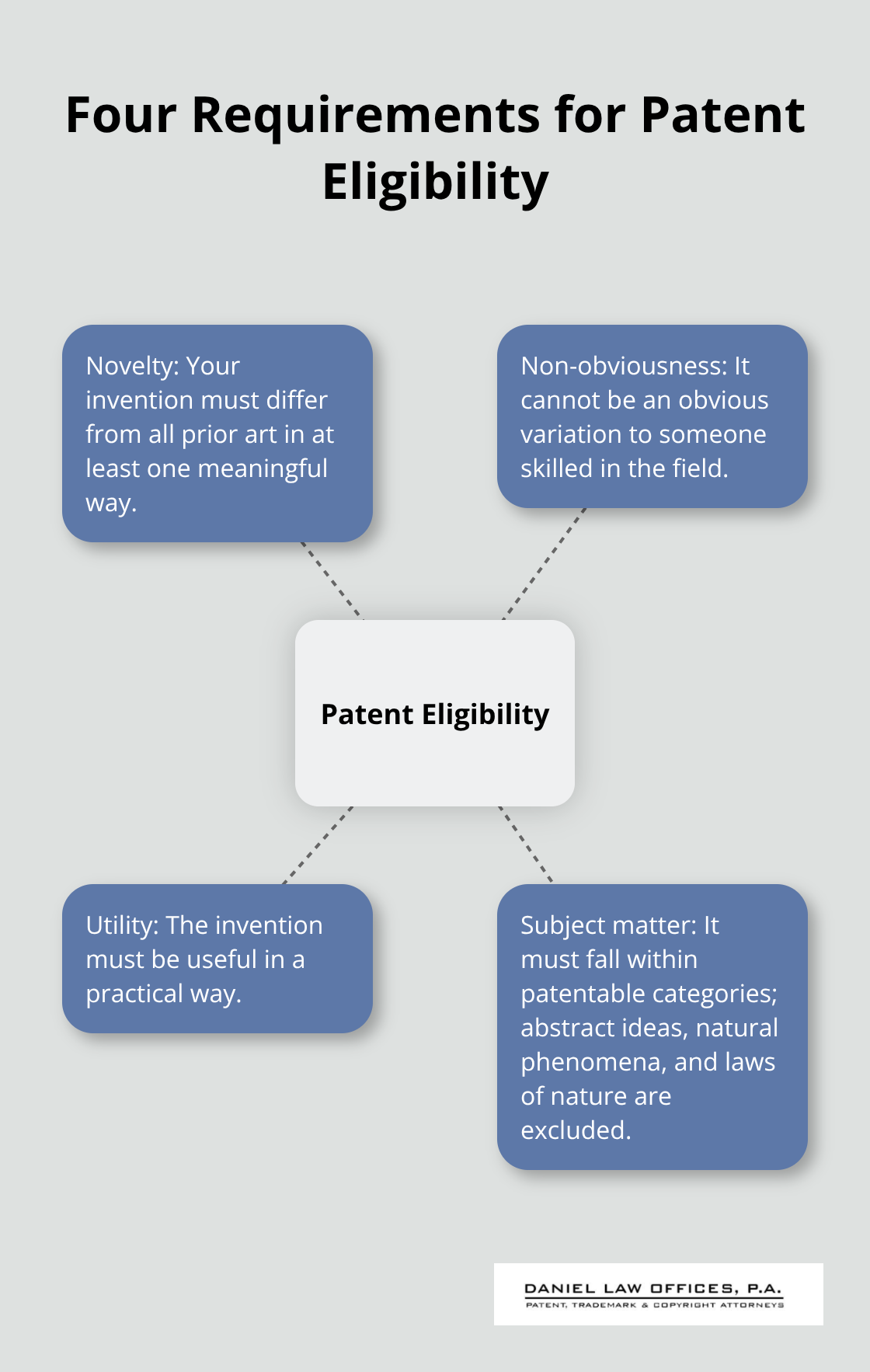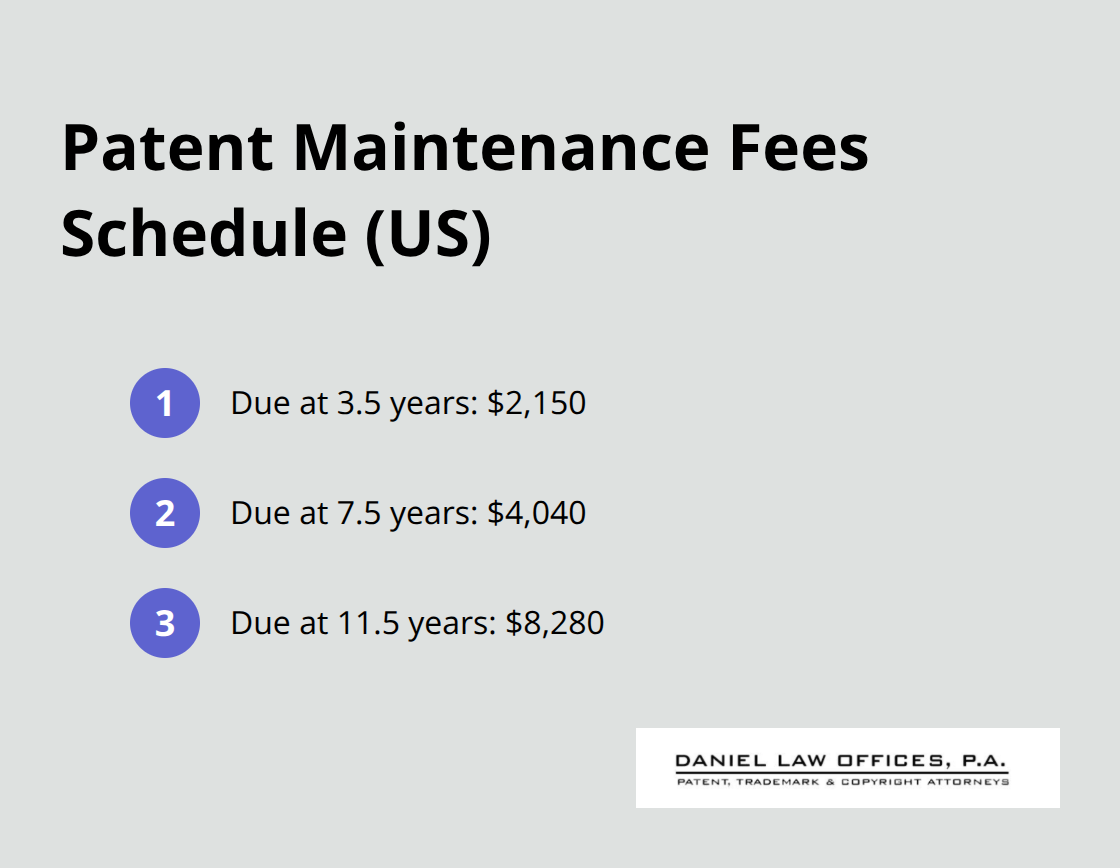US Patent Filing Process in Orlando, Florida From Idea to Approval
Turning your innovative idea into a protected patent requires navigating the complex US patent filing process. The journey from initial concept to USPTO approval involves multiple stages, strict deadlines, and detailed documentation.
We at Daniel Law Offices, P.A. guide inventors through each step of this process in Orlando, Florida. Understanding the requirements upfront can save you time and money while maximizing your chances of approval.
Understanding the US Patent Filing Process
Types of Patents Available in the United States
The United States offers three distinct patent types, each protecting different aspects of innovation. Utility patents cover new and useful processes, machines, articles of manufacture, or compositions of matter. These applications represent about 90% of all filings with the USPTO. Design patents protect the ornamental appearance of functional items, while plant patents cover asexually reproduced plant varieties. Most inventors in Orlando pursue utility patents since they provide the broadest protection for functional innovations.
Basic Requirements for Patent Eligibility
Your invention must satisfy four fundamental requirements to qualify for patent protection. The invention must be novel, which means it differs from all prior art in at least one meaningful way. The USPTO rejects approximately 8% of applications solely due to lack of novelty, which makes thorough prior art research essential.

Your invention must also be non-obvious to someone skilled in the relevant field, useful in some practical way, and fall within patentable subject matter. Abstract ideas, natural phenomena, and laws of nature cannot receive patent protection (regardless of how innovative they appear).
Timeline and Costs Associated with Patent Filing
Patent applications involve substantial financial investment with basic USPTO fees that range from $80 for micro entities to $320 for large entities as of 2023. Total costs typically reach $5,000 to $15,000 when you include attorney fees, according to American Bar Association data.

The USPTO charges an additional $400 non-electronic filing fee, which makes electronic submission through Patent Center the smart choice. The examination process takes 18-24 months for initial examination, with the entire process stretching 2-4 years based on complexity. Maintenance fees of $2,150, $4,040, and $8,280 become due at 3.5, 7.5, and 11.5 years respectively to keep your patent active.
Success in patent applications requires thorough preparation before you submit your documentation to the USPTO.
How Do You Build a Strong Patent Application
Patent application success depends on three foundation elements that determine whether your invention receives protection. Professional patent searches increase approval likelihood by 10% according to USPTO data, while comprehensive documentation prevents the 15% of patent invalidations that stem from inadequate disclosure. The Orange County Library System in Orlando assisted over 500 local inventors with patent inquiries in 2022, which demonstrates the high demand for proper search methodology.
Patent Search Strategy That Works
Start your search with the USPTO’s free patent database, but understand its limitations. Professional search services identify prior art that basic searches miss, which reduces your risk of the 8% rejection rate for lack of novelty. Focus on patents filed within the last 20 years in your technology area, then expand to international databases and non-patent literature. Document every relevant reference you find, as this information strengthens your application and helps you respond to examiner rejections later.
Application Content Requirements
Your patent application must average around 10,000 words with precise technical detail. Applications with well-drafted claims face 25% fewer initial rejections, which makes claim structure your top priority. Write independent claims that cover your invention’s broadest scope, then add dependent claims for specific embodiments. Include detailed descriptions of how your invention works, why it solves problems, and how someone skilled in the field could reproduce it.
Visual Documentation Standards
High-quality drawings correlate with 20% higher approval rates (so invest in professional patent illustrations that comply with USPTO standards). Patent drawings must include proper labels and maintain clarity when reduced to standard sizes. Over 90% of patent submissions utilize visual representations to illustrate inventions clearly. Your drawings should show every element mentioned in your claims and provide multiple views when necessary.
The next phase involves submission and examination, where your carefully prepared application faces USPTO review.
What Happens During USPTO Examination
Your application enters the USPTO examination queue after you file, where patent examiners review it against four patentability criteria. The first office action typically arrives within 15 months, though technology centers that handle software and business methods often take longer.

Approximately 86% of patent applications receive at least one non-final Office Action during examination, which means rejection on the first review is standard practice rather than failure. Patent examiners spend an average of 19 hours as they review each application, with their focus primarily on prior art searches and claim analysis.
How Office Actions Work
Office Actions categorize examiner feedback as non-final or final, each type requires specific response strategies within six months. Non-final rejections allow you to amend claims and argue against examiner positions, while final rejections limit your options to appeal or request continued examination. You must address every single point that the examiner raises in your response, as incomplete responses lead to application abandonment. The USPTO requires thorough responses that tackle each rejection with legal arguments and claim amendments where appropriate.
Interview Strategy That Increases Success
Applicant-initiated interviews with examiners increase approval chances by approximately 30% according to USPTO data, which makes direct communication your most powerful tool. Schedule these interviews before you submit written responses to understand examiner concerns and negotiate claim amendments that satisfy both parties. Examiners often provide guidance during interviews that they cannot include in written Office Actions (due to USPTO policies). These conversations help you craft responses that address the examiner’s actual concerns rather than what you think they mean.
Amendment Tactics That Preserve Value
Amendment strategies must balance claim scope with patentability requirements to maximize protection value. You should narrow your claims only when necessary to overcome prior art rejections, as overly restrictive amendments limit your patent’s commercial value. Submit continuation applications if you need to pursue broader claims that examiners initially rejected, which maintains your original priority date. The examination process averages 2-4 rounds of Office Actions before approval, so patience and persistence determine success more than perfect initial applications.
Final Thoughts
The US patent filing process requires careful preparation, strategic responses to USPTO feedback, and persistent follow-through across multiple examination rounds. Success rates improve dramatically when inventors conduct thorough prior art searches, draft comprehensive applications with professional-quality drawings, and respond effectively to Office Actions within required timeframes. Professional guidance helps inventors navigate this complex system and avoid common pitfalls that lead to application abandonment.
We at Daniel Law Offices, P.A. guide inventors through patent searches, application drafts, and USPTO prosecution while helping businesses protect their brand identity through trademark registration. Our experience with intellectual property law helps clients avoid mistakes that result in weak patent protection or abandoned applications. Patent attorneys provide valuable assistance throughout the entire process from initial filing to final approval.
Patent approval creates ongoing responsibilities that extend beyond the initial grant. You must pay maintenance fees at 3.5, 7.5, and 11.5 years to keep your patent active (the USPTO does not send reminders about these deadlines). Monitor your market for potential infringement and consider continuation applications to expand protection as your technology evolves. Patent approval marks the beginning of your intellectual property strategy rather than its completion.

